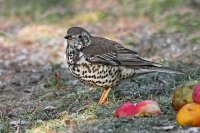Red-listed thrushes turn to gardens
13 Apr 2017 | No. 2017-13
Blackbirds were the most commonly seen bird in gardens during 2016, according to the annual results of British Trust for Ornithology’s (BTO) Garden BirdWatch. Good numbers of the Red-listed species Song Thrush and Mistle Thrush during the winter also provided a treat for Garden BirdWatchers. However, some birds did not fare as well and 2016 saw the lowest ever numbers of Greenfinches in gardens.
Spring numbers high after mild winter
The weekly records of BTO’s Garden BirdWatch allow us to track the yearly peaks and troughs of garden wildlife, and the annual results show a mixed picture for garden birds in 2016. The year started well, with a lot of bird activity and a bumper year for Siskins, which were reported in 27% of gardens in March, compared to an average (of all previous years) of only 18%. The proceeding mild winter is likely to have helped overwinter survival and high numbers of Wrens and Coal Tits were seen in gardens early in the year.
Rain hits breeding birds
However, in early summer we were hit by outbreaks of rain, which we believe had a detrimental effect on our breeding birds. We know that many birds suffered from a poor breeding season in 2016, and preliminary results of the BTO Nest Record Scheme show that 12% fewer Blue Tits fledged the nest compared to the five year average. From the summer onwards, there were fewer sightings of some commonly seen species such as Blue Tits and Great Tits in gardens and we are interested to see whether numbers will recover in 2017.
It was also a bad year for seeing Greenfinches, a species which has been in severe decline. From October onwards counts dropped below one per garden on average for the first time. The main contributory factor in this decline is thought to be disease.
A great winter for Song Thrushes
The winter gave some unexpected treats for Garden BirdWatchers as Waxwings increased by 442% on 2015. It was also a great winter to see Song Thrushes, a Red-listed species, which were seen more during the winter just gone than they had been for the last five years, being seen in 16% of gardens in December, compared to an average of 12% in a normal December. High numbers of Mistle Thrushes, (another Red-listed species) and Redwings were also reported, which could be due to the lack of natural food resources in the wider countryside, with more thrushes coming into gardens to find berries and fallen fruit. They were joined as always by Blackbirds, which this year topped the tables, being reported in an average of 90% of gardens throughout the year.
Claire Boothby, Garden BirdWatch Development Officer at the British Trust for Ornithology, said:
“Spring is progressing, summer migrants are coming back to the UK and many birds are busy nesting. It’s a good time to start looking out for young Blackbirds and Robins, and to listen for the distinctive song of Chiffchaffs. How will garden birds fare in 2017? We need your help to find out.”
To find out more about Garden BirdWatch and how you can get involved visit www.bto.org/gbw , email us at gbw [at] bto.org or call us on 01842 750050.
Contact Details
Claire Boothby
(Garden BirdWatch Development Officer)
Office: 01842 750050
Email: //press [at] bto.org" target="_blank">press//david.noble [at] bto.org" target="_blank">@bto.org
Paul Stancliffe
(BTO Media Manager)
Office: 01842 750050
(9am to 5:30pm)
Mobile: 07585440910
Email: press [at] bto.org ()
Images are available for use alongside this News Release. Please contact images [at] bto.org quoting reference April 2017 - 13
The BTO has an ISDN line available for radio interviews. Please contact us to book an interview. Office:01842 750050
Notes to editors
- The BTO Garden BirdWatch is the only nationwide survey of garden birds to run weekly throughout the year, providing important information on how birds use gardens, and how this use changes over time. It started in 1995 and currently has approximately 13,000 people take part. The project is funded by participants’ contributions and is the largest year-round survey of garden birds in the world. For more information see www.bto.org/gbw.
- To find out more about BTO Garden BirdWatch annual results for 2016 see https://www.bto.org/volunteer-surveys/gbw/results/annual-results
- You can find the 2016 Nest Record Scheme preliminary results here. People can contribute to nest records by taking part in Nest Box Challenge (NBC) an online survey of garden and nest boxes/sites with the aim of learning more about productivity trends of bird populations in urban areas. The BTO provides instructions on how to monitor and report nests on its website.
- The BTO is the UK's leading bird research charity. A growing membership and up to 60,000 volunteer birdwatchers contribute to the BTO's surveys, collecting information that underpins conservation action in the UK. The BTO maintains a staff of 100 at its offices in Thetford, Stirling, Bangor (Wales) and Bangor (Northern Ireland), who analyse and publicise the results of surveys and projects. The BTO's work is funded by BTO supporters, government, trusts, industry and conservation organisations. www.bto.org







Share this page